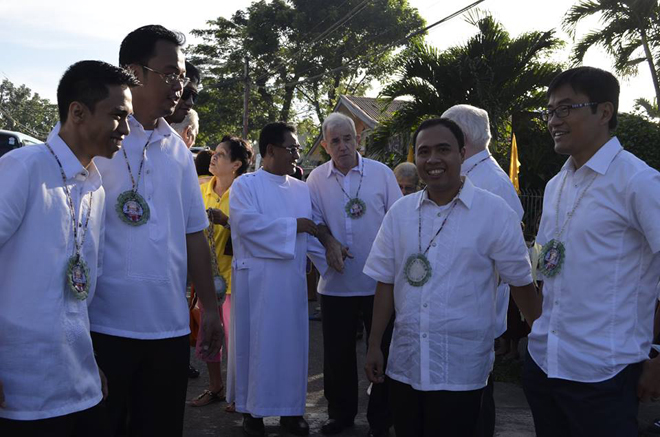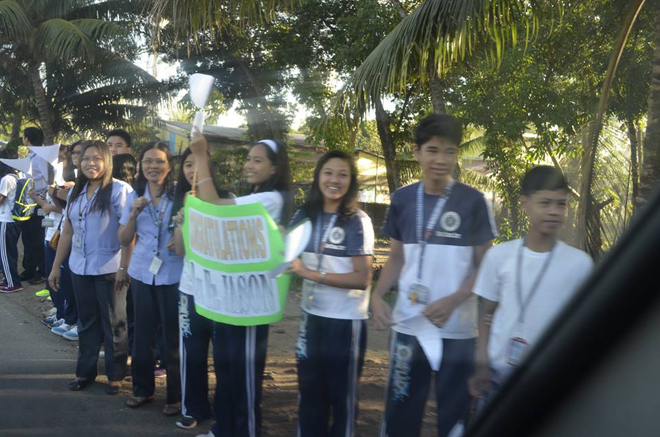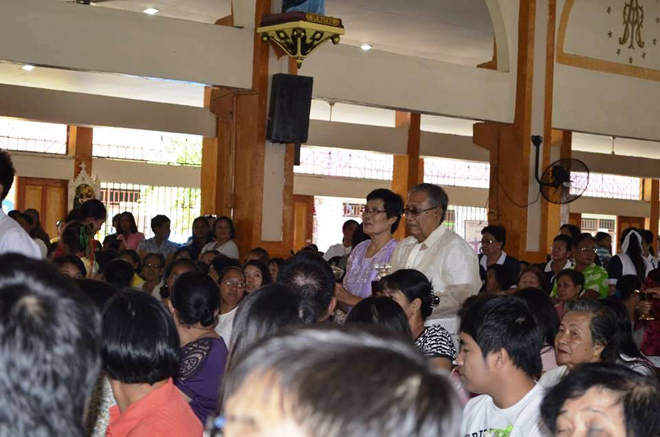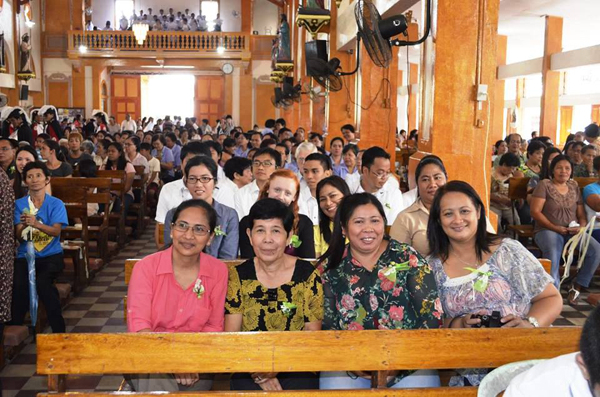Misyon Online - March-April 2015
Pulong ng Editor
‘This cathedral has been razed to the ground many times, but it refuses to disappear. It boldly rises from the ruins - just like the Filipino people.’
On 16 January Luis Antonio Cardinal Tagle, Archbishop of Manila, gave a welcoming speech to Pope Francis before the final blessing at the Mass in the Cathedral-Basilica of the Immaculate Conception in which bishops, priests, seminarians and religious participated. He spoke of the Cathedral as a symbol of the people, the church building as a symbol of the Church, the faithful. May his words lead us into a profound sense of gratitude for the gift of the faith that God has given each of us as individuals and all of us as his Church, especially here in the Philippines. Here is the text of the Cardinal’s talk.

‘What have I gotten myself into?’
By Anne Gubuan
There is something about witnessing an ordination ceremony that makes me cry. Maybe it’s the sentimentality of a son leaving his parents to serve the Lord. Maybe it’s the courage I see in these priest warriors, leaving everything and sacrificing so many things. Maybe it’s the feeling of being taken care of by God by sending us these brave and loving shepherds.

On 7 January this year I was privileged to attend yet another one of these very meaningful Catholic celebrations. San Isidro Labrador Parish of Binalbagan, Negros Occidental, rejoiced and thanked the heavens for their new priest, Fr Jason Atiquera.
Cardinal Tagle meets Deaf students in Bacolod City
Luis Antonio G. Cardinal Tagle, Archbishop of Manila, flew down to Bacolod City on 26 January to receive the Fides Award ffor his contribution to Quality Christian Education.


An Interview with Naya
By Fr Chris Saenz
This article was written when Fr Saenz, a frequent contributor to MISYONonline.com, was still parish priest in La Pintana. The interview took place on 5 February 2014.
Nayade Constanza Rocha Canales, known to family and friends as ‘Naya’, is a 16-year-old adolescent who suffers from Spina Bifida. Spina Bifida, the Latin for ‘split spine’, is characterized by the incomplete development of the brain, spinal cord, and/or meninges - the protective covering around the brain and spinal cord. Naya’s condition has confined her to a wheelchair. She is an intelligent adolescent who dreams of being a teacher; or a doctor who treats children and adolescents. She enjoys being with her family and going to school. She lives with her maternal grandparents Rosa and Alejo whom she affectionately calls ‘Mama and Papa’. They have taken care of Naya, who has a distant relationship with her mother, since she was born.

From Fear to Friendship
By Beth Sabado
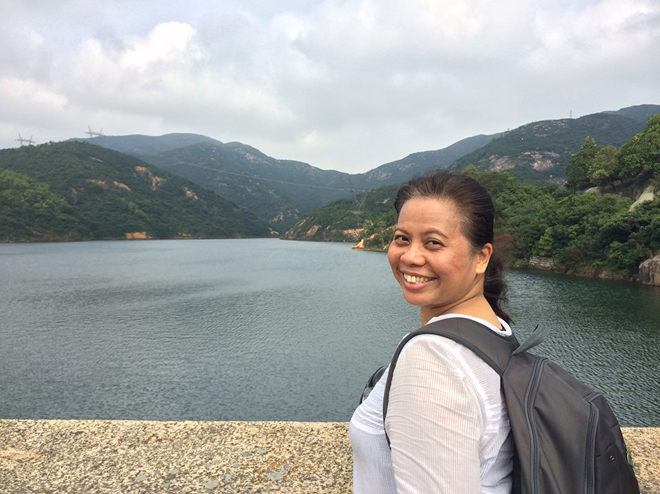
Beth Sabado, hiking in Hong Kong
The author recently finished a three-year term in Hong Kong as Coordinator of the Lay Missionary Central Leadership Team and is currently awaiting a new assignment.
My pilgrimage in, indeed my conversion to, interreligious dialogue started even before I learned the meaning of the word dialogue. Both my parents were from Luzon in the northern Philippines, but in 1946, soon after World War II, my father decided to migrate south to Pagadian, Zamboanga del Sur. At the time the town, which became a city in 1969, was predominantly Muslim, according to my father. My mother had a similar migration story and so my parents, even though neither was born there, met and married in Mindanao.

St Columban's Day – With Kachin Trimmings…
By Fr Patrick Colgan
Fr Pat Colgan, from Northern Ireland, was based in Fiji before being elected to the General Council of the Missionary Society of St Columban. The Council members live in Hong Kong.
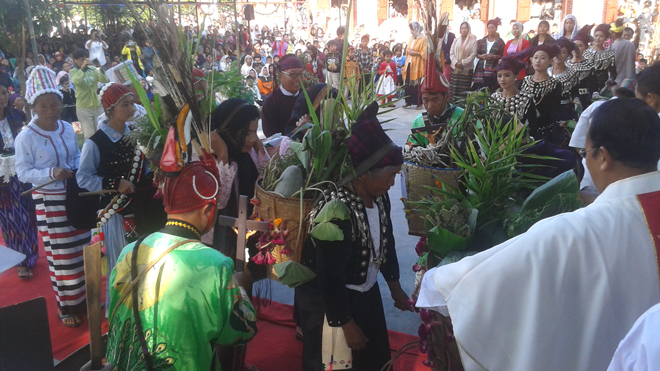
Offertory Procession
A Kachin Dance
St Columban’s Day 2014 came early in the hills of Kachin State. Over 2,000 people had already started boarding trains for the three-day journey to Yangon, the capital of Myanmar, for the upcoming national 500th anniversary celebrations of the arrival of the Catholic faith (initially through Portuguese traders) due to be the held the following weekend. So it was decided to have the local diocesan Jubilee celebration, an ordination to the diaconate, and St Columban’s Day – the saint is patron of Myitkyina Diocese - all on 15 November.
About 3,000 representatives from many parishes gathered in the early morning at Edin, the large piece of land containing St Luke’s Catechists’ School, founded by Australian Columban Fr Bernard Way, for Mass at 730am. We were led by a loud Kachin marching band to the grotto prepared for the outdoor celebration.

What Missing the Harvest Meant on His Journey
by Richelle H. Verdeprado
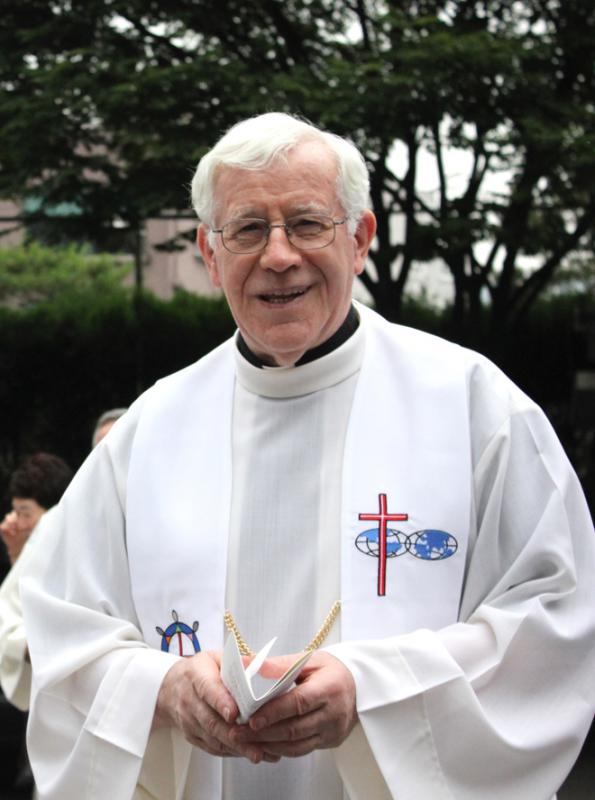
They say that our circle of friends can influence who we become. This is particularly true of Fr. Liam O’Keeffe who became a missionary priest after deciding to follow in the footsteps of a school friend who went to the Columban seminary, Dalgan Park, near Navan, Ireland. Since then it has become a decision that is being continually affirmed as he goes on meeting people and going to places where the love of Jesus is shown through the presence of Columbans.

Gandhi, with a French interpreter
‘Whenever you are confronted with an opponent, conquer him with love.’
― Mahatma Gandhi
Psalm 16 Good News Translation (GNT)

Pulong ng Editor
‘This cathedral has been razed to the ground many times, but it refuses to disappear. It boldly rises from the ruins - just like the Filipino people.’
On 16 January Luis Antonio Cardinal Tagle, Archbishop of Manila, gave a welcoming speech to Pope Francis before the final blessing at the Mass in the Cathedral-Basilica of the Immaculate Conception in which bishops, priests, seminarians and religious participated. He spoke of the Cathedral as a symbol of the people, the church building as a symbol of the Church, the faithful. May his words lead us into a profound sense of gratitude for the gift of the faith that God has given each of us as individuals and all of us as his Church, especially here in the Philippines. Here is the text of the Cardinal’s talk.
Manila Cathedral today
Most Holy Father,
Before you are representatives of the bishops, priests, religious men and women and lay faithful of the Philippines and of Asia. In their name I welcome you to our country, to the city of Manila and to the Cathedral Basilica of the Immaculate Conception. Welcome. Benvenuto. We are filled with joy for you are with us, especially in the first Eucharistic celebration of your pastoral visit.

Manila Cathedral before the 1880 earthquake
The Manila Cathedral is the first cathedral church in the Philippines. It can be considered a symbol of the Filipino people. Fire destroyed the first cathedral. The succeeding five cathedrals were either partially or totally damaged by earthquakes, the most massive of which struck in 1863 burying in rubble the members of the cathedral chapter, the choir and the lay faithful.

Manila Cathedral after the 1880 earthquake
The seventh cathedral was mercilessly bombed along with the other buildings in the Walled City of Manila (Intramuros) during the battle of liberation in 1945. We are gathered today, Your Holiness, in the eighth cathedral building. And we closed three years ago for repairs. Now it is open and it warmly welcomes you. This cathedral has been razed to the ground many times, but it refuses to disappear. It boldly rises from the ruins - just like the Filipino people. Yes, Holy Father, we bishops, priests and religious men and women have seen and have lived the suffering, but also the determination of our people. ‘We are afflicted in every way possible, but we are not crushed’ (2 Corinthians 4:8).
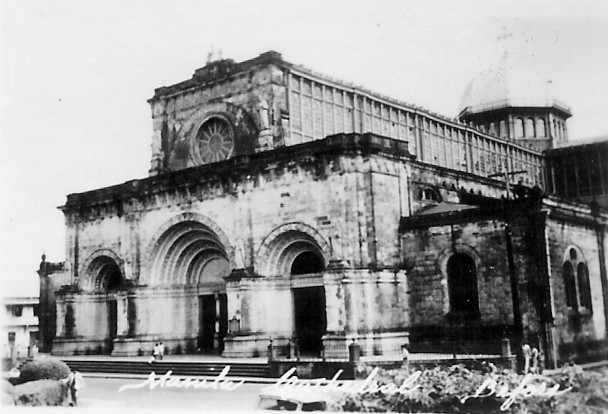
Manila Cathedral before the Allied bombing of February 1945
What is the secret of the resilience of the Filipinos? Fr. Horacio de la Costa, your confrere, a Jesuit, historian, writer, priest, religious and nationalist, provides an insight. He said that the Filipino has two treasures: We have two ‘wealths’: music and faith. La musica y la fede. Our melodies make our spirits soar above the tragedies of life. Our faith makes us stand up again and again after deadly fires, earthquakes, typhoons and wars. And now, as many of our poor people are just beginning to rise from recent natural and human-made calamities, as we are struggling, you, Holy Father came to us.

Manila Cathedral after the bombing of February 1945
You bring fire, not to destroy but to purify. You bring an earthquake, not to shatter but to awaken. You bring weapons, not to kill but to assure, to encourage. Indeed, ‘you are Peter, the Rock upon which Jesus builds His Church’ (Matthew 16:18). You are Peter who comes ‘to strengthen your brothers and sisters in faith’ (Luke 22:32). We welcome you, successor of Peter, to this blessed land of untiring hope, of infinite music and of joyful faith. With your visit, we know Jesus, only Jesus, will renew and rebuild His Church in the Philippines. Mabuhay po kayo, Santo Padre!

The Cathedral today
All photos from Wikipedia.
An Interview with Naya
By Fr Chris Saenz
This article was written when Fr Saenz, a frequent contributor to MISYONonline.com, was still parish priest in La Pintana. The interview took place on 5 February 2014.
Nayade Constanza Rocha Canales, known to family and friends as ‘Naya’, is a 16-year-old adolescent who suffers from Spina Bifida. Spina Bifida, the Latin for ‘split spine’, is characterized by the incomplete development of the brain, spinal cord, and/or meninges - the protective covering around the brain and spinal cord. Naya’s condition has confined her to a wheelchair. She is an intelligent adolescent who dreams of being a teacher; or a doctor who treats children and adolescents. She enjoys being with her family and going to school. She lives with her maternal grandparents Rosa and Alejo whom she affectionately calls ‘Mama and Papa’. They have taken care of Naya, who has a distant relationship with her mother, since she was born.
Naya with her Mama Ros
I first met Naya when I was assigned to work in the parish of Santo Tomás Apostol in Santiago. [Link ‘Santo Tomas Apostol’ to https://es-es.facebook.com/sto.tomas.apostol ] She was attending First Communion classes in the Padre Hurtado Chapel. I observed her as an outgoing, joyful adolescent who enjoyed participating in the chapel. I was curious about her life and faith. She agreed to be interviewed.
Naya, how did you arrive at the Padre Hurtado chapel?
Three years ago I told my Mama Rosa and Papa Alejo that I wanted to make my First Communion and I kept asking them when, when, when? Eventually, my Mama Rosa took me to the parish we were living in. (Technically, Naya lives in another parish that borders on our parish). We joined the First Communion program there but one day my mother could not go to a class because I was having health problems. The parish told her that we could no longer attend the program because my mother missed one class. (In Chile, parents also are required to attend catechesis). I really wanted to make my First Communion because I wanted to receive the host, the Body of Christ, and I prayed so much for my family.
Naya with Mama Rosa and Fr Chris
So what did you do? What happened next?
A year later our neighbor, Mrs Isabel, who is involved in activities at Padre Hurtado chapel, invited us to join. She took us to a Mass celebrated by Columban Father John Boles, an Englishman who was parish priest at the time,I really enjoyed it. There I saw good people. They were welcoming, and greeted all as they arrived. There was a sense of solidarity in the chapel. And Father John was very welcoming and a good companion to us. We talked to him about the possibility of my joining the First Communion program in the chapel.
What did Father John say?
Father John said that in another chapel - in Chile, a parish consists of a number of chapel communities -there was a Special Catechesis program for people like me that involved only one year of preparation. But it was quite far and my being in a wheelchair would make it difficult for me to attend the weekly classes. Father John said I could participate in the Padre Hurtado chapel, which was closer, but that the preparation was two years. He left it for us to decide. Of course, we decided to join the Padre Hurtado chapel program.
How was the experience of participating in catechesis?
We formed good friendship with the other children. What I really liked was the works of charity we did. We tried to help those who had no food or place to sleep. For instance, some mornings, as a group, we went out and handed out food to people who didn’t have anything. It was the first time I ever did something like that. It was a very good experience.
On the day of your First Holy Communion, how did you feel?
I was really nervous but happy to be with my catechesis companions. Also, I was happy to receive Jesus. When I received the Body and Blood of Christ I felt a sense of relief and welcoming. I felt it in my heart and mind. Most of all, I had my family present to share the experience.
Now that you have mad your First Holy Communion, what do you want to do?
I have always dreamed of being at the altar. I would like to be an altar server. I want to help you and the other priests at the altar. For me the altar is a great emotion of joy.
For you, what does it mean to be Catholic?
To be an obedient child. To respect all, especially those who love you very much. Always take care of the other.
What can you say about the Columbans?
Columbans are very joyful priests and good people. They are very attentive to the needs of the other. What I like most about them is their support of children who really need help.
What message would you like to give to our readers around the world?
If you have children, please support them in what they need. If you have family who live far away, find a way to continue to provide and support them. Always make sure your family has what it needs.
[I asked her Mama Rosa the following]
What was it like for you to attend catechesis?
It was difficult for me at first. I found it hard to express myself. But in time, the themes of the class touched daily life and I was able to share with the other parents. We discovered we had a lot in common.
Did you see any changes in Naya after catechesis?
Yes, before Naya was very impulsive and often grumpy. Now I see she is more serene and tranquil. She has learned to listen.
End Note: We plan to train Naya to be an altar server. I have asked the community to build a little ramp to the altar so that she can go up to the altar. We will work out the logistics of what she will do. Naya is extremely happy to have this opportunity.
You may email the author at gchris.saenz@gmail.comCardinal Tagle meets Deaf students in Bacolod City

Luis Antonio G. Cardinal Tagle, Archbishop of Manila, flew down to Bacolod City on 26 January to receive the Fides Award ffor his contribution to Quality Christian Education.
Despite his trip being a one-day one Cardinal Tagle made room in the afternoon to meet Deaf students and staff of Welcome Home Foundation, Inc. (WHFI), started in 1986 by Columban Fr Joseph Coyle who died in 1991. His work was continued and expanded largely through the efforts of the late Mrs Salvacion V. Tinsay, known as ‘Tita Salving’, who had worked for many years with Father Joe and who died in 2008. Her daughter Mrs Agnes T. Jalandoni now directs the work as President of WHFI. The Columban connection has remained down the years, with Fr Seán Coyle the current chaplain.
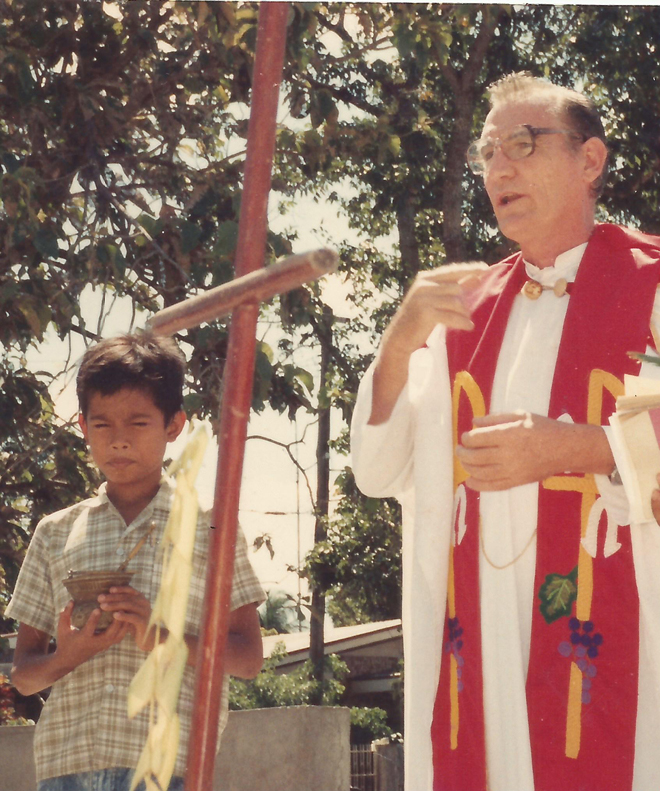
Fr Joseph Coyle
When Cardinal Tagle used some Sign Language with the young Deaf people at the Carmelite Monastery in Bacolod City, where he later met the nuns, their faces broke into large smiles. Cardinal ‘Chito’, as he is widely known in the Philippines, bantered with the Deaf and asked if any of them had been at the Papal Mass in Manila on 18 January. The young Deaf taught him to count in their language.
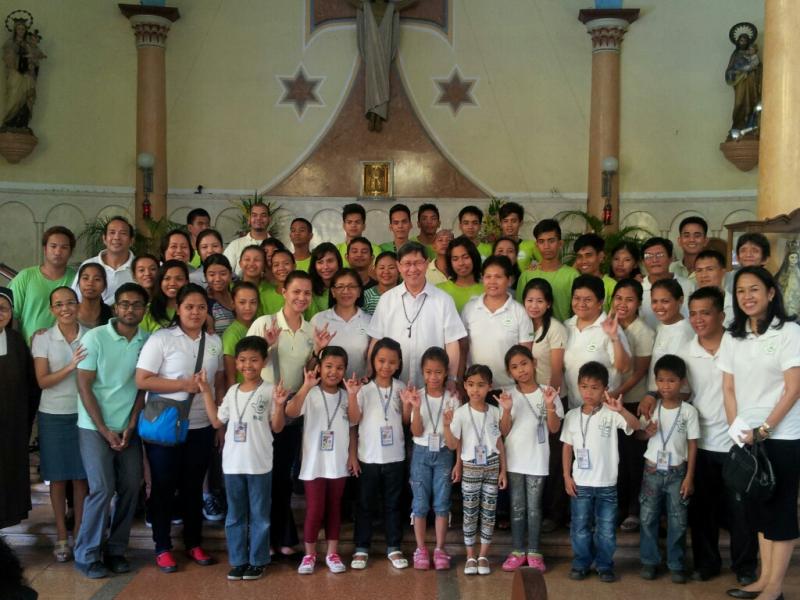
Cardinal ‘Chito’ in turn asked them to pray for Pope Francis and to reach out to more Deaf persons. He shared with them a particularly poignant moment when Pope Francis met survivors of Typhoon Haiyan/Yolanda (7 November 2013) and the earthquake in Bohol (15 October 2013). The Holy Father was quiet and groaned as he listened as they recounted their painful ordeal of losing loved ones. When Cardinal Tagle asked him if he had anything to say to them he answered, ‘What can I tell them?’ He was just one with them and that was what mattered.
All were silent as they listened to the Cardinal. All the Deaf present approached him to be blessed and to show him how much they appreciated him.
Thank God for Cardinal Tagle and for Pope Francis!
Renato G. Cruz and his wife Anastacia, a profoundly deaf couple, and their five children, all hearing, teach Pope Francis how to say ‘Thank you’ in Sign Language.
What Missing the Harvest Meant on His Journey
by Richelle H. Verdeprado
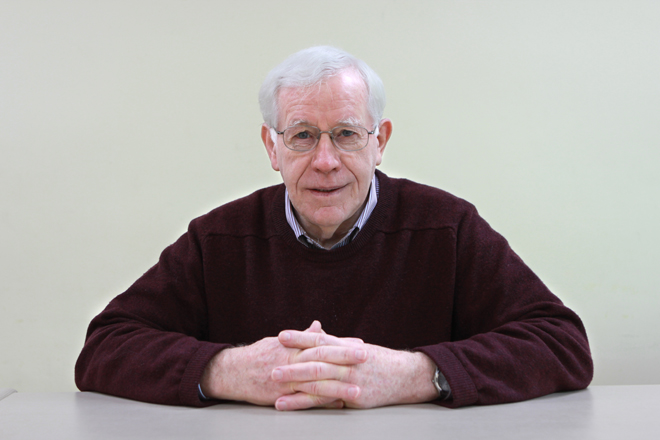
They say that our circle of friends can influence who we become. This is particularly true of Fr. Liam O’Keeffe who became a missionary priest after deciding to follow in the footsteps of a school friend who went to the Columban seminary, Dalgan Park, near Navan, Ireland. Since then it has become a decision that is being continually affirmed as he goes on meeting people and going to places where the love of Jesus is shown through the presence of Columbans.
Around County Clare, Ireland
Father Liam is from the parish of Kilmurry Ibrickane, County Clare, on the Atlantic coast of the west of Ireland. He was born in 1940, the seventh of eleven children.
>
Our Lady Star of the Sea Church, Quilty, one of three churches in the parish
[Wikipedia,
Eddylandzaat]
Building Not Only Structures
After finishing high school, the young Liam worked in the office of a construction contractor for a little over a year. He was fascinated with buildings but felt that something was lacking. Perhaps, he was being called to build something else, like a community of people fighting for justice, a community where God is the center of everything. He suddenly thought about his friend and then found himself knocking on the door of the seminary where he was to spend the next seven years, making more discoveries about himself, about his faith and how that faith can touch others. The location of the seminary in the middle of a large farm supported moments of reflection.

Missing the Harvest Season
But being on a farm made him think about home, as he grew up on a dairy farm more than 200 kms from the seminary. Life in the seminary was challenging with its daily round of prayer, study, recreation, and generally was rewarding and pleasant. Homesickness though was a struggle for him. After home vacations at Christmas, Easter and especially the long summer break he would experience a minor crisis. He would leave his family and the farm where barley, oats and potatoes were grown. The return to the seminary after the summer break was the hardest because it was heart-breaking to miss the harvesting work. As Father Liam said, ‘There are difficult things on the farm, but harvesting is fun and rewarding.’
Ennistymon, where Father Liam attended high school [Wikipedia]
But he learned to deal with that with the help of his friends and companions. It was like embracing the awareness that maybe he was called to do a different kind of ‘harvesting.’ He would remain focused and began to accept his homesickness without letting it overpower him. It was something that would not last for long anyway, while God was revealing wonderful experiences and opportunities to him each time, thereby making the struggles simply part of the background while the desire to be a missionary was the highlight of everything.
Doolin, County Clare, before the harvest
The Highlights
When Father. Liam shared such deep reflections, I thought of the many shapes and forms of suffering we may experience in life. Along the way, we may find ourselves getting so overwhelmed by them that we focus on problems that are just part of the ‘background’. Thus, we may miss the highlights - the beauty of life and the greater purpose to which we are called. The words of Father Liam are reminders that we should remain focused on our goals, of our being Christians. Father Liam also shared about the value of prayer. Prayer is not just a part of life but in a real sense is life itself. Prayer makes our faith a living thing.
After 25 Years
Father Liam was happy to be back in the Philippines. His first visit was 25 years ago when he spent time with the late Fr Niall O’Brien. Apart from a short spell in Australia he has spent all of his missionary years in Korea. Father Liam’s heart is close to Filipinos. In Korea, he works with Filipino migrant workers, most of whom are employed in factories. He is also involved with multi-culture families, and women struggling to fight for their rights. He has seen how Filipinos triumph in hard times and in the face of challenges. In Korea he sees how Filipinos cope with the challenges of a new climate, a difficult new language, and unfamiliar customs. At the Columban Central House in Seoul, where he lives, a small group of Filipinas gather every month for Mass and for educational and livelihood training activities.

The Cliffs of Moher, Atlantic Coast, looking south [Wikipedia]
When asked what makes him happy, he shared that it is meeting people, sitting with them, hearing their stories, their struggles and achievements that has colored his life as a Columban missionary. He admires his fellow missionaries, Columbans and others, and their work, people who have dedicated their lives to doing good for others. He admires all who remain faithful to God whatever situation in life they are in - all who struggle for righteousness while facing and overcoming challenges.
From Fear to Friendship
By Beth Sabado

Beth Sabado, hiking in Hong Kong
The author recently finished a three-year term in Hong Kong as Coordinator of the Lay Missionary Central Leadership Team and is currently awaiting a new assignment.
My pilgrimage in, indeed my conversion to, interreligious dialogue started even before I learned the meaning of the word dialogue. Both my parents were from Luzon in the northern Philippines, but in 1946, soon after World War II, my father decided to migrate south to Pagadian, Zamboanga del Sur. At the time the town, which became a city in 1969, was predominantly Muslim, according to my father. My mother had a similar migration story and so my parents, even though neither was born there, met and married in Mindanao.
Mindanao, a little larger than Ireland, is the second largest island in the Philippines and is a place where sizeable numbers of Muslims and Christians dwell together.
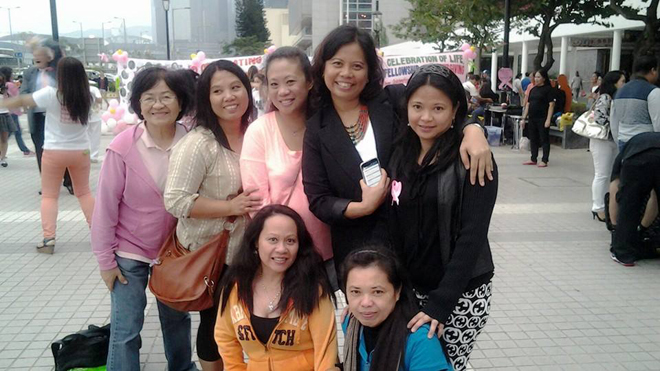
Beth Sabado, friends in HK
At home, we spoke the language of my parents, Ilokano, the predominant language in northern Luzon, rather than Cebuano, the language of the south. This only stirred my curiosity about Cebuano and, unknown to my parents, I even tried to learn some of it. As a child, simply by listening to my playmates, I was already speaking Cebuano before I was aware of it.
As I was growing up, my parents were continually talking about going to court because of a land dispute. My father held a title proving his ownership of a piece of land, but the Muslim chief said that such a title was just a piece of paper and that the real owners of the land were his ancestors.
For us this was a strange notion of private property. This land dispute created an atmosphere of fear and we felt a coldness and ambivalence towards Muslims. These feelings were not confined to our immediate family, but they certainly contaminated our relatives and the families of the tenants on our farm.
After finishing college and passing the nursing exams up north, I went to Pagadian City where I spent nine years working in J. Cabahug Hospital and became Head Nurse. My nine years there not only enhanced my nursing skills, but also taught me to show respect to all the clients coming to the hospital and to begin to appreciate social and cultural differences. It gave me a great opportunity to build rapport with Muslims and to get to know them as persons. They were our main clients.
My previous assumption that Muslims were land-grabbers and criminals was gradually replaced by a relationship of empathy and respect. I became not only their nurse, but their friend. It helped liberate me from fear, mistrust and ambivalence.
Our school books contained simple explanations about beliefs, practices and rituals of other religions, but the books I read did not deal much with how to respect and celebrate our differences.
To fully understand and appreciate religious and cultural differences, I believe that we must have a complete head-to-heart conversion. For me, this involved changing my long held perspective from seeing God as associated with Church and primarily with Christians, to seeing God as a person who is present to all peoples and present in all religions.
In 2002, when I joined the Columban Lay Missionaries, the subject of interreligious dialogue was part of our orientation. It affirmed my earlier conviction that differences of beliefs should not be the basis for defining who we are, but, rather should be a space in which to understand and respect one another.
I worked for nine years in the migrant ministry at the Hope Workers’ Centre in Taiwan. There we assisted migrant works from Indonesia, Thailand, Vietnam, the Philippines and Cambodia.
Given the countries that most of the migrant workers came from, I was able to encounter a variety of religions. I found that people’s religious beliefs and background are important aspects of their ability to understand and cope with their situation.
I am reminded of a telephone call I received at the crack of dawn from the Taiwanese parish priest of the church where the Hope Workers’ Centre is based. (Read Beth’s Walking with Overseas Workers) He was apologetic, but he appealed to me to go to the center as soon as possible, because a migrant worker had been brought by a taxi driver and seemed to be in a lot of pain. I rushed on my motorbike to the center. [Link ‘Walking with Overseas Workers’ to http://www.misyononline.com/new/may-jun2006/walking-with-overseas-workers ]
There I saw a man soaked in blood, lying curled in front of the gate of the church, moaning in pain. Some neighbors had gathered around helplessly. When I arrived, they explained that he was an Indonesian migrant worker who had been locked up by his broker.
Afraid he would be repatriated to his homeland, he managed to escape through a second-floor window by knotting his clothes and a blanket together. When the knot gave way he fell from a height, but managed to crawl beside the road until a taxi driver helped him and drove him to the church.
The human dynamics in that scenario made me reflect. I had been summoned to that man. I pray that when a stranger needs help my response will be spontaneous, because I see Christ in him.Our life journey has to be grounded in trust and in the goodness found in the diversity of our beliefs and cultures.
It is my hope that one day people will call each other by name and not by labels of creed and race.
This is how I see God - no limits, no boundaries, but a Being who is present to everyone, and in the midst of every group, regardless of ‘tribe and tongue, people and nation’ (Revelations 5:9).
You may email the author at madamsaturday.ms@gmail.com
Peace By Peace

Gandhi, with a French interpreter
‘Whenever you are confronted with an opponent, conquer him with love.’
― Mahatma Gandhi
Psalm 16 Good News Translation (GNT)
A Prayer of Confidence
Protect me, O God; I trust in you for safety.
I say to the Lord, “You are my Lord;
all the good things I have come from you.”
How excellent are the Lord's faithful people!
My greatest pleasure is to be with them.
Those who rush to other gods
bring many troubles on themselves.
I will not take part in their sacrifices;
I will not worship their gods.
You, Lord, are all I have,
and you give me all I need;
my future is in your hands.
How wonderful are your gifts to me;
how good they are!
I praise the Lord, because he guides me,
and in the night my conscience warns me.
I am always aware of the Lord's presence;
he is near, and nothing can shake me.
And so I am thankful and glad,
and I feel completely secure,
because you protect me from the power of death.
I have served you faithfully,
and you will not abandon me to the world of the dead.
You will show me the path that leads to life;
your presence fills me with joy
and brings me pleasure forever.
The ‘White Helmets’ of Syria
Prayer for Peace in the Philippines
On 25 January 44 members of the Philippine National Police, and others, were killed in an encounter in Mamasapano, Maguindanao, a province in Mindanao. The Catholic Bishops’ Conference of the Philippines suggests that this prayer be prayed before the Prayer after Communion at Masses from 1 March till 28 March. Archbishop Socrates Villegas of Lingayen-Dagupan, President of the CBCP, wrote to his fellow bishops:
‘As the nation continues to grieve over the tragedy in Mamasapano and the family of nations is threatened by war and terror from extremist groups, our best contribution to the nation and to the world is to encourage people to pray . . .
‘I respectfully propose that we the bishops of the Philippines encourage our people to pray the following Oratio Imperata for Peace. Hopefully this prayer can calm the anxieties of our long suffering people and touch the hearts of the enemies of peace.’
The decision to include this prayer in Mass belongs to the bishop of each jurisdiction.
Lord of Peace, we come to You in our need
Create in us an awareness
of the massive forces of violence and terrorism
that threaten our world today.
Grant us a sense of urgency
to activate the forces of goodness, of justice,
of love and of peace in our communities.
Where there is armed conflict,
let us stretch out our arms to our
brothers and sisters.
Where there is abundance and luxury,
let there be simple lifestyle and sharing.
Where there is poverty and misery,
let there be dignified living and constant striving for just structures.
Where there is selfish ambition, let there be humble service.
Where there is injustice, let there be humble atonement.
Where there is despair, let there be hope in the Good News.
Where there are wounds of division, let there be unity and wholeness.
Where there are lies and deceit, let your Truth set us all of us free.
Where there are thoughts of vengeance, let there be healing and forgiveness.
Help us to be committed to the Gospel of peace.
In spite of our differences in faith traditions and ethnic roots,
Teach us Your spirit of mercy and compassion.
For it is only in loving imitation of you, Lord of Peace,
that we can discover the healing springs of life
that will bring about new birth to our earth
a new era of peace
and a new harmony among all
Forever and ever. Amen.
Floribert Bwana Chui: a Martyr to Corruption
Floribert Bwana Chui of the Democratic Republic of the Congo (DRC), a member of the Community of Sant’Egidio, was murdered in 2007 for refusing a bribe.
St Columban’s Day – With Kachin Trimmings…
By Fr Patrick Colgan
Fr Pat Colgan, from Northern Ireland, was based in Fiji before being elected to the General Council of the Missionary Society of St Columban. The Council members live in Hong Kong.

Offertory Procession
A Kachin Dance
St Columban’s Day 2014 came early in the hills of Kachin State. Over 2,000 people had already started boarding trains for the three-day journey to Yangon, the capital of Myanmar, for the upcoming national 500th anniversary celebrations of the arrival of the Catholic faith (initially through Portuguese traders) due to be the held the following weekend. So it was decided to have the local diocesan Jubilee celebration, an ordination to the diaconate, and St Columban’s Day – the saint is patron of Myitkyina Diocese - all on 15 November.
About 3,000 representatives from many parishes gathered in the early morning at Edin, the large piece of land containing St Luke’s Catechists’ School, founded by Australian Columban Fr Bernard Way, for Mass at 730am. We were led by a loud Kachin marching band to the grotto prepared for the outdoor celebration.
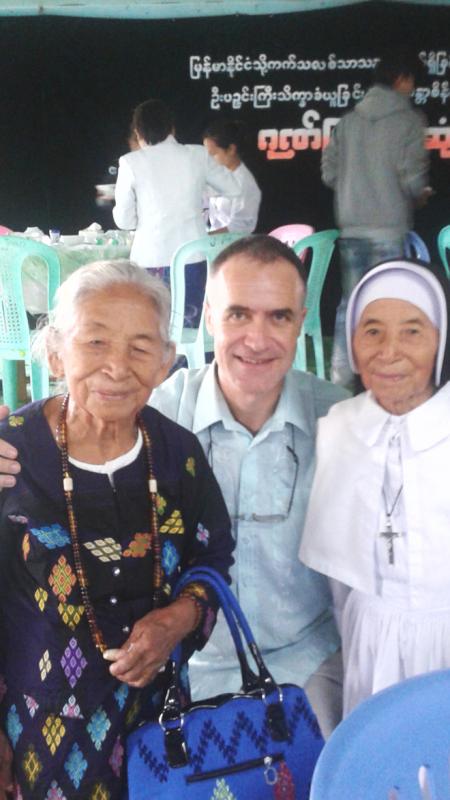
Pat with 2 sisters of Kachin Bishop Paul Grawng
What followed was a mixture of the Roman ordination rite, a Kachin gong ceremony, a colorful offertory dance and some presentations after Communion, including an unusual and poignant item from a group of young men, some in traditional dress and some in paramilitary fatigues, with symbols depicting the Kachin dream of having a homeland under local administration. This potentially risky gesture, given the precarious stage of ongoing negotiations between the Myanmar government and Kachin independence groups, occasioned both loud cheers and quieter tears. (Three days later, the Burmese army dropped a bomb on a KIA training camp in nearby Laiza., killing 23.).
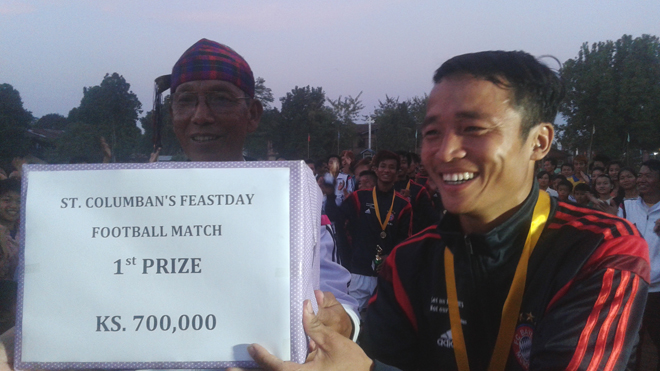
1st Prize to Edin !
After the brief presentaitons, the words of thanks and the bishop’s final blessing, all went either to a dining room, or received a lunch box, with rice (boiled and glutinous ‘sticky’ varieties), pork (ten pigs had been either bought or donated for slaughter), some curries, and for the chief guests – Columbans and Kachin elders - fermented rice wine, poured from bamboo stalks. A number of the elders had been students of St Columban’s College, before it was nationalised by the military in the early 1960s, and attributed their careers, in politics, the civil service and for their people’s independence struggle, to the good English taught them by the ‘Irish Fathers’!
Jubilee Celebrations, Banmaw (Bhamo), 2012
The Diocese of Banmaw (Bhamo) was separated from the Diocese of Myitkyina in 2006. Both constitute the area where the Columbans first went in 1936. Thhis video was one of many made on the occasion of the 75th anniversary of the arrival of the Columbans.
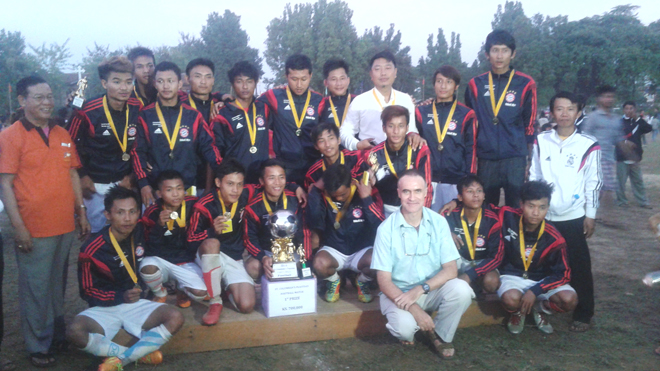
Edin team with Bishop Francis Daw Tang (left)
We then waited excitedly for the start of the St Columban’s Cup Football final in the Edin ground, the prizes for which we had donated this year. 17 teams had been whittled down to a final between Edin (the hosts) and Yuzana sub-parish. Edin made an impressive outing, winning 3-0, and received their cash prize along with the winners of the badminton, volleyball and caneball competitions. Caneball, known as ‘Chinlone’, is the traditional sport of Myanmar/Burma. These sports tournaments are seen by the diocese as an important plank in their drug rehabilitation and youth ministries. The production and use of pium is unfortunately a major problem in Kachin State, exacerbated by both poverty and the ongoing political conflict.

Men playing caneball in Myanmar [Wikipedia, Thomas Schoch]
It seemed very fitting that two anniversaries, the 1,400th since the death of
St Columban in 615, and the 500th year of the presence of the Catholic faith in
Myanmar, were celebrated together, in the year when we in the Missionary Society
of StColumban missionaries are preparing to reopen our mission among the Kachins. The Columban Sisters returned there some years ago. In my few words at a welcoming ceremony that evening for two newly ordained Korean Columban priests, Fr Carlo Jung and Fr Jehoon Lee, on a short visit to the place where they will be taking up their assignment later this year, I shared that although the Society does not have the big number of young priests that it had before, we are happy to send, ‘from our poverty’, what we have to the Kachin people, knowing that it will once again be a blessing for them and for us . I hope that the four Columban priests resting gently in the nearby cemetery will smile at that, and will guide our new team, Columban lay missionaries and priests, to many more good St Columban’s Days among these determined but gentle people.
‘What have I gotten myself into?’
By Anne Gubuan
There is something about witnessing an ordination ceremony that makes me cry. Maybe it’s the sentimentality of a son leaving his parents to serve the Lord. Maybe it’s the courage I see in these priest warriors, leaving everything and sacrificing so many things. Maybe it’s the feeling of being taken care of by God by sending us these brave and loving shepherds.
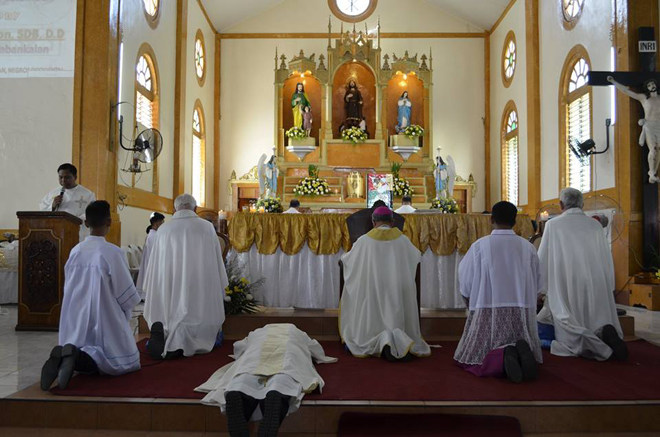

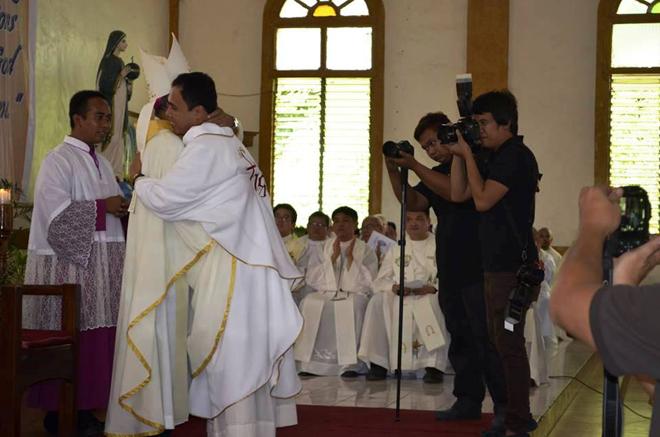
On 7 January this year I was privileged to attend yet another one of these very meaningful Catholic celebrations. San Isidro Labrador Parish of Binalbagan, Negros Occidental, rejoiced and thanked the heavens for their new priest, Fr Jason Antiquera. Offering his life to God as a Columban missionary priest, Father Jason felt very much at peace and happy just thinking about his life ahead. On the days leading to his ordination he spent time alone with God, thanking him for choosing him. But when visitors from other parts of the country and from different parts of the world started arriving to be at the ordination he was deeply overwhelmed and found himself asking, ‘What have I gotten myself into?’ It started to sink in, the reality that he was about to embark on a path less taken. ‘Visitors walked the extra mile just to witness my ordination. There’s no way that I should disappoint them,’ Father Jason shared.
As if hearing what Father Jason’s heart was saying, Bishop Patricio A. Buzon SDB of the Diocese of Kabankalan, answered that in his homily during the ordination by reminding Father Jason that it wasn’t going to be easy. ‘You will be like Christ the priest, but you will also be like Christ the victim. It’s being nailed to the cross. It’s scary,” the bishop emphasized. There was total silence when he said these words, slowly and very carefully describing for Father Jason how it was going to be. ‘But Jesus himself said that apart from him, you can do nothing. Pray. Pray without ceasing,” he urged Father Jason. And that also went for the rest of the congregation present. He asked the people to pray for our priests, for our nuns, for our bishops, for our Pope, for our lay workers. He put so much emphasis on prayer, saying that it is very important that all of us should dedicate our lives as Christians. Praying will lead us closer to the Father and will make us want to take an active role in the mission of the Church.
My most favorite part of the ordination was the prostration where the Reverend Jason, still a deacon, was lying face down on the floor and the assembly kneeled and prayed the Litany of the Saints. I savored every line. I called on the saints like I had never done before, asking for the help of all of them for Father Jason, for the seminarians, for those searching about this vocation, for the young men of this generation who aren’t quite certain what they want to do with their lives. ‘Please God, call them to be your priests.’ I prayed for my own son who expressed his desire to be a pope upon ‘meeting’ Pope Francis on TV. I prayed for the mothers, fathers, guardians who are raising and guiding young ones that they may love them and nurture them in God’s love and ways so that they too can be like Father Jason.
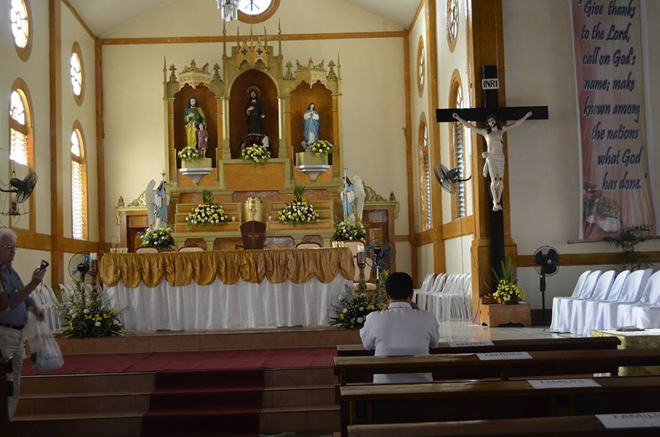
At the reception, I was privileged to meet Father Jason’s parents, Wilfredo and Amalia, and I had a warm chat with his mother. She recalled how as a baby, the young Jason became their town’s ‘living Jesus’ in the town’s Christmas Belen. ‘Maybe that time his vocation had already started,’ she mused happily. She was so thrilled at the fact that when St John Paul II was here in the Philippines in 1981 she was two months pregnant with Jason, and she offered him in a prayer to God: ‘Make him grow into a loving and faithful Christian.’ And now, on the occasion of her son’s ordination, another pope, Francis, was about to visit the Philippines. When asked what her secret was in raising a would-be priest, she closed her eyes and with emphasis said, ‘I prayed. I prayed, not every day but every minute and every second. I prayed every step of the way as Jason and his siblings were growing. I prayed constantly, never ceasing, never faltering.’
For Father Jason it was a bit of a surprise knowing his mother had offered him to God already when he was just two months in her womb. But looking at his smile, I could see his peace in knowing that indeed, he has now gotten himself into where God wants him to be.

Columban Ordinations
A
Columban ‘First’
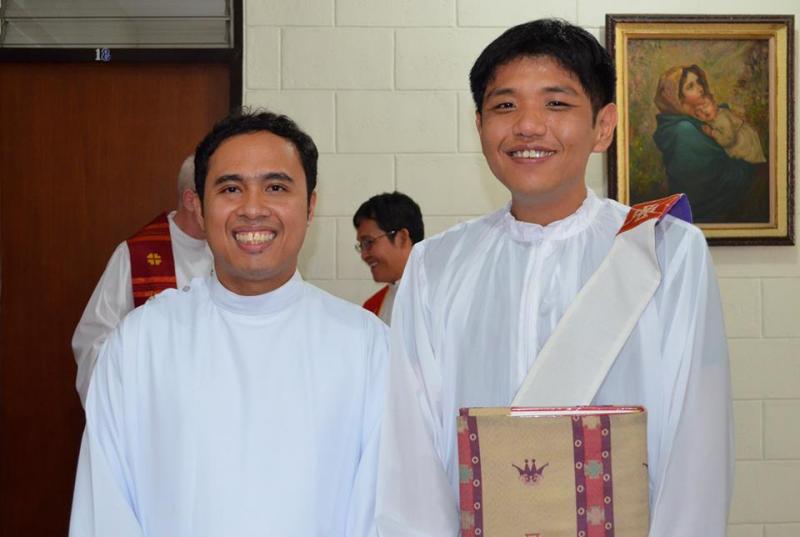
Jason Antiquera and Reverend
Just before the ordination to the diaconate of Jason, 29 June 2014
Fr Jason Platon Antiquera is from San Isidro Labrador Parish, Binalbagan, one of four parishes in the southern part of the Diocese of Bacolod, which then included the whole of Negros Occidental, given to the Columbans in 1950 to take care of and to develop. In 1987 this territory became the new Diocese of Kabankalan. Father Jason is the first Columban priest from the diocese.
Father Jason is currently serving at Our Lady of Remedies Parish, Malate, Manila, where Columbans have worked since 1929 when they first arrived in the Philippines. He has already spent time there as a seminarian on First Mission Assignment. He has also spent some time in Peru as a seminarian. He will take up his first overseas assignment as a priest in Korea on 1 September.
Fr Jehoon Augustine Lee was ordained to the priesthood in Seoul, Korea, on 1 November 2014. He spent two years on First Mission Assignment, in the Diocese of Novaliches.

Silver Jubilee of Fr Raymond Husband
Fr
Raymond Husband
The Silver Jubilee of Fr Raymond Husband, ordained in Ireland on 17 December 1989. Was celebrated on 8 December at the central house of the Columbans in Maniila on 8 December.
Father Ray is currently the Vice-Director of the Region of the Philippines and Rector of the Columban House of Studies and Spiritual Formation House, Cubao, Quezon City
FIn the words of the old Latin blessing: Ad multos annos! ‘To many years!’
Frs Jason Antiquera and Raymond Husband




